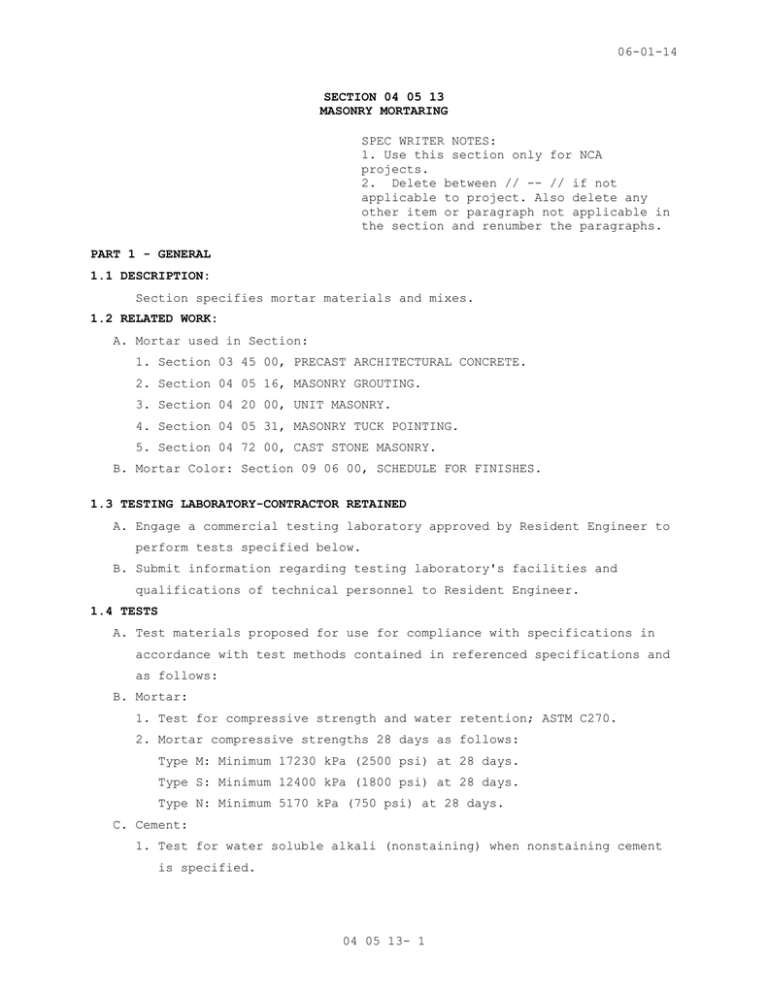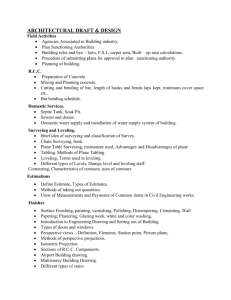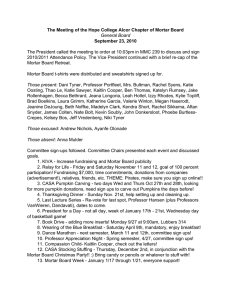06-01-14 SPEC WRITER NOTES: 1. Use this section only for NCA projects.
advertisement

06-01-14 SECTION 04 05 13 MASONRY MORTARING SPEC WRITER NOTES: 1. Use this section only for NCA projects. 2. Delete between // -- // if not applicable to project. Also delete any other item or paragraph not applicable in the section and renumber the paragraphs. PART 1 - GENERAL 1.1 DESCRIPTION: Section specifies mortar materials and mixes. 1.2 RELATED WORK: A. Mortar used in Section: 1. Section 03 45 00, PRECAST ARCHITECTURAL CONCRETE. 2. Section 04 05 16, MASONRY GROUTING. 3. Section 04 20 00, UNIT MASONRY. 4. Section 04 05 31, MASONRY TUCK POINTING. 5. Section 04 72 00, CAST STONE MASONRY. B. Mortar Color: Section 09 06 00, SCHEDULE FOR FINISHES. 1.3 TESTING LABORATORY-CONTRACTOR RETAINED A. Engage a commercial testing laboratory approved by Resident Engineer to perform tests specified below. B. Submit information regarding testing laboratory's facilities and qualifications of technical personnel to Resident Engineer. 1.4 TESTS A. Test materials proposed for use for compliance with specifications in accordance with test methods contained in referenced specifications and as follows: B. Mortar: 1. Test for compressive strength and water retention; ASTM C270. 2. Mortar compressive strengths 28 days as follows: Type M: Minimum 17230 kPa (2500 psi) at 28 days. Type S: Minimum 12400 kPa (1800 psi) at 28 days. Type N: Minimum 5170 kPa (750 psi) at 28 days. C. Cement: 1. Test for water soluble alkali (nonstaining) when nonstaining cement is specified. 04 05 13- 1 06-01-14 2. Nonstaining cement shall contain not more than 0.03 percent water soluble alkali. D. Sand: Test for deleterious substances, organic impurities, soundness and grading. 1.5 SUBMITTALS A. Submit in accordance with Section 01 33 23, SHOP DRAWINGS, PRODUCT DATA, AND SAMPLES. B. Certificates: //1. Testing laboratory's facilities and qualifications of its technical personnel. // 2. Indicating that following items meet specifications: a. Portland cement. b. Masonry cement. c. Mortar cement. d. Hydrated lime. e. Fine aggregate (sand). //f. Color admixture.// C. Laboratory Test Reports: 1. Mortar, each type. 2. Admixtures. D. Manufacturer's Literature and Data: 1. Cement, each kind. 2. Hydrated lime. 3. Admixtures. 4. Liquid acrylic resin. 1.6 PRODUCT DELIVERY, STORAGE AND HANDLING A. Deliver masonry materials in original sealed containers marked with name of manufacturer and identification of contents. B. Store masonry materials under waterproof covers on planking clear of ground, and protect damage from handling, dirt, stain, water and wind. 1.7 APPLICABLE PUBLICATIONS A. Publications listed below form a part of specification to extent referenced. Publications are referenced in text by basic designation only. B. American Society for Testing and Materials (ASTM): C40-11..................Organic Impurities in Fine Aggregates for Concrete C91-12..................Masonry Cement 04 05 13- 2 06-01-14 C109-11.................Compressive Strength of Hydraulic Cement Mortars (Using 2-in. or 50-MM Cube Specimens) C144-04.................Aggregate for Masonry Mortar C150-12.................Portland Cement C207-06(2011)...........Hydrated Lime for Masonry Purposes C270-12.................Mortar for Unit Masonry C595-13.................Blended Hydraulic Cement C780-10.................Preconstruction and Construction Evaluation of Mortars for Plain and Reinforced Unit Masonry C979-10.................Pigments for Integrally Colored Concrete C1329-12................Mortar Cement PART 2 - PRODUCTS SPEC WRITER NOTE: Make material requirements agree with applicable requirements specified in the referenced Applicable Publications. Update and specify only that which applies to the project. 2.1 HYDRATED LIME ASTM C207, Type S. 2.2 AGGREGATE FOR MASONRY MORTAR A. ASTM C144 and as follows: 1. Light colored sand for mortar for laying face brick. 2. White plastering sand meeting sieve analysis for mortar joints for pointing // and laying of structural facing tile units except that 100 percent passes No. 8 sieve, and not more than 5 percent retained on No. 16 sieve. // B. Test sand for color value in accordance with ASTM C40. Sand producing color darker than specified standard is unacceptable. 2.3 BLENDED HYDRAULIC CEMENT ASTM C595, Type IS, IP. 2.4 MASONRY CEMENT A. ASTM C91. Type N, S, or M. //B. Use white masonry cement whenever white mortar is specified. // 2.5 MORTAR CEMEMT ASTM C1329, Type N, S or M. 2.6 PORTLAND CEMENT A. ASTM C150, Type I. //B. Use white Portland cement wherever white mortar is specified. // 04 05 13- 3 06-01-14 2.7 LIQUID ACRYLIC RESIN A formulation of acrylic polymers and modifiers in liquid form designed for use as an additive for mortar to improve physical properties. 2.8 WATER Potable, free of substances that are detrimental to mortar, masonry, and metal. 2.9 POINTING MORTAR A. For Cast Stone or Precast Concrete: Proportion by volume; One part white Portland cement, two parts white sand, and 1/5 part hydrated lime. //B. Pointing Mortar for Glazed Structural Facing Tile: 1. Proportion by volume: One part white Portland cement, two parts of graded white sand passing Number 50 sieve, and 1/8 part hydrated lime.// //2. Pointing mortar in shower: Add aluminum tri-stearate, calcium stearate, or ammonium stearate in amount of two percent of weight of cement used. // 2.10 MASONRY MORTAR A. Conform to ASTM C270. B. Admixtures: 1. Do not use mortar admixtures, except color admixtures if approved by Resident Engineer. 2. Submit laboratory test report showing effect of proposed admixture on strength, water retention, and water repellency of mortar. 3. Do not use antifreeze compounds. C. Colored Mortar: 1. Maintain uniform mortar color for exposed work throughout. 2. Match mortar color in approved sample // or mock-up. // 3. Color of mortar for exposed work in alteration work to match color of existing mortar unless specified otherwise in section 09 06 00, SCHEDULE FOR FINISHES. D. Color Admixtures: 1. Proportion as specified by manufacturer. 2. For color, see Section 09 06 00, SCHEDULE FOR FINISHES. 2.11 COLOR ADMIXTURE A. Pigments: ASTM C979. B. Use mineral pigments only. Organic pigments are not acceptable. 04 05 13- 4 06-01-14 C. Pigments inert, stable to atmospheric conditions, nonfading, alkali resistant and water insoluble. PART 3 - EXECUTION 3.1 MIXING A. Mix in a mechanically operated mortar mixer. 1. Mix mortar for at least three minutes but not more than five minutes. B. Measure ingredients by volume. Measure by the use of a container of known capacity. C. Mix water with dry ingredients in sufficient amount to provide a workable mixture which will adhere to vertical surfaces of masonry units. //D. Mortar that has stiffened because of loss of water through evaporations: 1. Re-tempered by adding water to restore to proper consistency and workability. 2. Discard mortar that has reached its initial set or has not been used within two hours. E. Pointing Mortar: 1. Mix dry ingredients with enough water to produce a damp mixture of workable consistency which will retain its shape when formed into a ball. 2. Allow mortar to stand in dampened condition for one to 1-1/2 hours. 3. Add water to bring mortar to a workable consistency prior to application. // 3.2 MORTAR USE LOCATION A. Use Type M mortar for // precast concrete panels, // and // waterproof parging below grade, //. B. Use Type S mortar for // masonry containing vertical reinforcing bars (non-engineered) // masonry below grade // masonry solar screens // and // setting cast stone // and // engineered reinforced unit masonry work //. C. For brick veneer over frame back up walls, use Type N portland cementlime mortar or Type S masonry cement or mortar cement mortar. D. Use Type N mortar for other masonry work, except as otherwise specified. E. Use Type N mortar for tuck pointing work. // //F. Use pointing mortar for items specified. // 04 05 13- 5 06-01-14 - - - E N D - - - 04 05 13- 6




